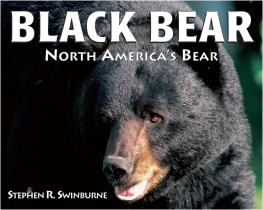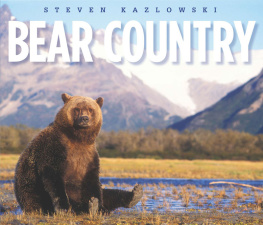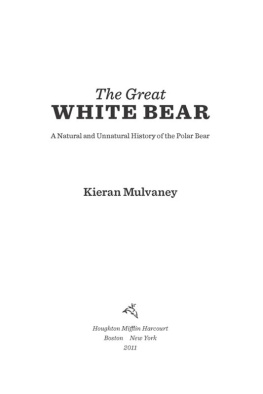
BEAR ATTACKS
OF THE CENTURY
Copyright 2005 by Larry Mueller and Marguerite Reiss
ALL RIGHTS RESERVED. No part of this book may be reproduced or transmitted in any form by any means, electronic or mechanical, including photocopying and recording, or by any information storage and retrieval system, except as may be expressly permitted in writing from the publisher. Requests for permission should be addressed to The Lyons Press, Attn: Rights and Permissions Department, P.O. Box 480, Guilford, CT 06437.
The Lyons Press is an imprint of The Globe Pequot Press.
A majority of the pieces here appeared in slightly different form in Outdoor Life magazine.
Printed in the United States of America
10 9 8 7 6 5 4 3 2 1
Designed by Sheryl Kober
ISBN 1-59228-810-3
The Library of Congress has previously cataloged an earlier (paperback) edition as follows:
Library of Congress Cataloging-in Publication Data
Mueller, Larry.
Bear attacks of the century : true stories of courage and survival / Larry Mueller and Marguerite Reiss.
p. cm.
ISBN 1-59228-270-9 (trade pbk.)
1. Bear attacksAnecdotes. I. Reiss, Marguerite. II. Title.
QL737.C27M84 2005
599.78'156'6dc22
2005040749
Larry:
To Micky, my perfect wife of fifty-five years, who has suffered a bear of an attack from the most dreaded malady in our society. And to the Cedar Ridge saints, the kind, loving, and so incredibly patient nurses and nurses aids at Cedar Ridge Healthcare Center who are caring for her around the clock since it became abundantly clear that, despite our determination to do so, my daughter, Anne, and I could not accomplish it ourselves.
Marguerite:
To William Wennen, M.D. FACS. The stories here are pain-filled almost beyond human endurance. But to Alaska surgeon Bill Wennen, the iron thread that runs through bear attacks is courage by contagiona quality akin to empathy, which brings hundreds to his office offering whatever they can to help victims of bear maulings.
To Drs. Glenn and Eva Oids. Constantly on the lookout to make others' lives better. To them I am inexpressibly grateful for the chance to write and sell adventure stories on the Last Frontier.
To Frances Halpern, host of Beyond Words on KCLU, an NPR affiliate, moderator for the Los Angeles Times Festival of Books, former Los Angeles Times columnist; a relentless cheerleader of my writing.
And to Bruce Barbour of Barbour Books, a colleague who believed.
ACKNOWLEDGMENTS
To editors Richard Schneider, Vin Sparano, Fulton Oursler Jr., Ken Gilmore, Mary Aikins, Marlane Liddell, Laurie Harper of the Sebastian Agency; and Alaska outdoors writer, Craig Medfred. To encouragers Melinda Milheim, B. J. Krevitz, Col. Eric Wheaton, Lowell Thomas Jr., Larry Hausmann, Dr. Ted and Ellie Rubin, Eunice Borrelli. To writers Jan Ingram, Dalene Perrigo, Thetus Smith, Doris Thomas, Dianne Barske, Susan Ohrberg, Asta Corley, Carol Sturgulewski, Millie Spezialy, Carolyn Rinehart, Elaine Williamson, Emily McKenzie, Pat Richardson, Ella Wright.To doctors Charles Herndon, Donna Chester, Fred Hillman, Mark Mills, James Schafer, Arthur Manoli, Jeff Morin. To members of the New York City Explorers Club, the Alaska Press Women, the Red Cedar Friends Meeting and Unitarian Church, both of Lansing, Michigan, and to Calvin Kern for constant, generous help.
INTRODUCTION
Bear Attacks of the Century is a book that opens a fearful wound as old as man himself. We can indeed imagine how it felt to be slower, weaker, and too lacking in jaw to bite back in a world populated with huge, efficient predators. And it's unpleasant to be reminded that even today there's a chance that something may want to eat us any time we enter bear country. Nobody reads a bear attack story and says, Wow! What an adventure! I'd like to try that. Yet, by something deep within, we seem drawn to the primeval nature of bear attacks. I call it a community survival instinct, developed by eons of dodging large animal jaws. We are encouraged when we hear that a victim fought courageously and won. Or we express admiration when the victim's partner coolly maneuvers in position and waits for a shot that will kill the bear, but not his buddy. And it's heartwarming to know that there are others out there, friends and strangers alike, who unhesitatingly take heroic measures to evacuate the victim, get him to an appropriate hospital, or just show up and wait in line to give him lifesaving blood.
Nevertheless, as might be expected, not everyone has inherited the community survival instinct. So far, however, we've only found one example. Bruce Brown, an archer since high school, thought that the ultimate hunting challenge would be taking a grizzly by bow and arrow. His coworker and hunting buddy, David Delapina, would accompany him as backup. According to 1990 newspaper accounts, both carried short-barreled 12-gauge pump shotguns loaded with three-inch slugs. Bruce also carried a shoulder-holstered .44 Magnum semiautomatic pistol under his left arm.
The two split up to double their chances of spotting a bear. Seeing a young grizzly walk out onto a gravel bar, Bruce approached to about twenty yards, and accurately placed an arrow into its vitals. The bear made it into thick brush before dropping dead. Bruce went back for David, and the men returned to find two more bears on the scene. David suggested they back off. Bruce didn't follow his suggestion. David did back off about twenty yards. One of the bears, looking straight at Bruce, started walking toward him. At thirty yards, Bruce fired a warning shot, which prompted the bear to charge. Taking one step backward, Bruce's feet tangled in brush and he fell, jamming dirt into his shotgun's receiver. It didn't matter. In a thirty-yard run, a bear can be on top of a man before he can pump another shell into the chamber.
The bear grabbed Bruce by the head and swung him in a half circle, and then let go, apparently because it didn't like the feel of the right hand that Bruce managed to shove into its mouth. It crunched the hand. Bruce kicked the bear and got swung by the leg. With Bruce yelling for help, David fired a shot and missed. He pumped the shotgun and pulled the trigger again, but nothing happened. The bear turned its head and looked at David, who thought he was next. Believing that his gun had jammed (more likely he had short stroked the pump action, and the second shell had not reached the chamber) he ranand didn't stop until he had climbed into a tree stand that he had seen earlier.
Finally, a badly battered Bruce managed to twist his left hand enough to pull the pistol from the holster under his left arm. Firing several shots, he broke the bear's neck. Bruce called for David who had heard the shots, but didn't hear the calling and thought Bruce was dead. David stayed up the tree while Bruce struggled back to the truck and drove it thirty miles to a ranger station. Bruce understood why David might run away from the bear to safely unjam his gun, but he couldn't understand why David didn't return to help. Michael Carey of the Anchorage Daily News best summed up how most people who know bears feel about what David did: It's perfectly understandable and equally unforgivable.
One other point I'd like to make is that readers sometimes expect outdoor ordeal stories to be sensationalized. Not in this book. Bear attacks are horrible enough just as they happen. In fact, we have taken great pains to avoid phrases that could be labeled hyperbole. We have also given great attention to detail. Marguerite lived in Alaska and still visits annually. She finds most of the stories and runs them past me. If we both agree that all elements of an outstanding story are there, she begins taping interviews, and then sends me a word-for-word transcript. Although I have the story in the victim's exact words, few people tell their tales in chronological order. They may start in the middle of the attack, then switch back and forth with bits and pieces of how it came about and how it ended. It's my job to reassemble the parts in logical sequence. We often find pieces missing, so Marguerite does a bit more interviewing. By now, we essentially have the story, but some details may not quite ring true to me, possibly because I'm a lifelong outdoorsman and Marguerite, an excellent writer and interviewer, would rather see large animals through bars of cages. So it's my turn to talk with the people involved and get fine details that make me think I can clearly see it happening. After it's written, they get a copy to read for accuracy. Only when they are satisfied that it reads exactly as it occurred does it go to the editor. We have exaggerated nothing. Nor have we glossed over anything. Horrifying as the encounters were, what you read is what these people experienced.
Next page






